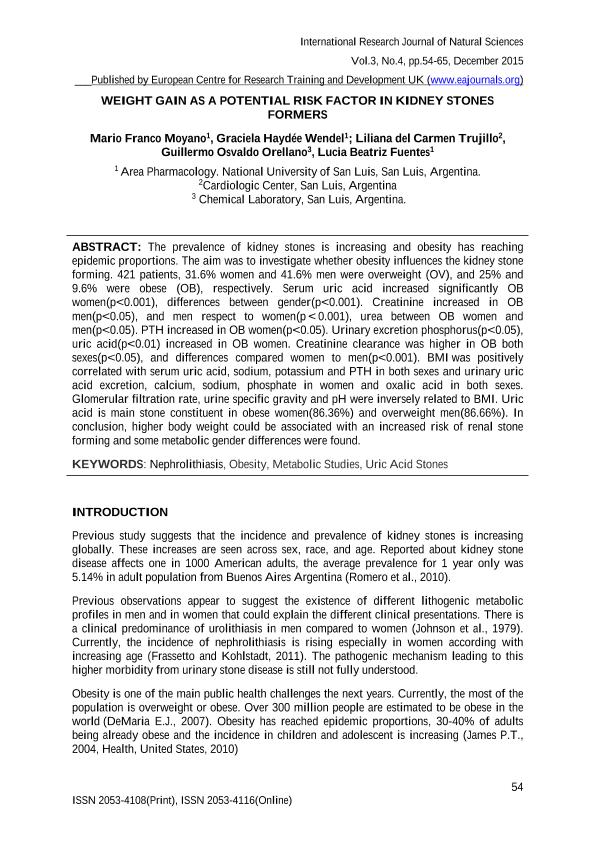Artículo
Weight gain as a potential risk factor in kidney stones formers
Moyano, Mario Franco ; Wendel, Graciela Haydée; Trujillo, Liliana del Carmen; Orellano, Guillermo Osvaldo; Fuentes, Lucia Beatriz
; Wendel, Graciela Haydée; Trujillo, Liliana del Carmen; Orellano, Guillermo Osvaldo; Fuentes, Lucia Beatriz
 ; Wendel, Graciela Haydée; Trujillo, Liliana del Carmen; Orellano, Guillermo Osvaldo; Fuentes, Lucia Beatriz
; Wendel, Graciela Haydée; Trujillo, Liliana del Carmen; Orellano, Guillermo Osvaldo; Fuentes, Lucia Beatriz
Fecha de publicación:
12/2015
Editorial:
European Centre for Research Training and Development
Revista:
International Research Journal of Natural Sciences
ISSN:
2053-4108
e-ISSN:
2053-4116
Idioma:
Inglés
Tipo de recurso:
Artículo publicado
Clasificación temática:
Resumen
The prevalence of kidney stones is increasing and obesity has reaching epidemic proportions. The aim was to investigate whether obesity influences the kidney stone forming. 421 patients, 31.6% women and 41.6% men were overweight (OV), and 25% and 9.6% were obese (OB), respectively. Serum uric acid increased significantly OB women(p<0.001), differences between gender(p<0.001). Creatinine increased in OB men(p<0.05), and men respect to women(p < 0.001), urea between OB women and men(p<0.05). PTH increased in OB women(p<0.05). Urinary excretion phosphorus(p<0.05), uric acid(p<0.01) increased in OB women. Creatinine clearance was higher in OB both sexes(p<0.05), and differences compared women to men(p<0.001). BMI was positively correlated with serum uric acid, sodium, potassium and PTH in both sexes and urinary uric acid excretion, calcium, sodium, phosphate in women and oxalic acid in both sexes. Glomerular filtration rate, urine specific gravity and pH were inversely related to BMI. Uric acid is main stone constituent in obese women(86.36%) and overweight men(86.66%). In conclusion, higher body weight could be associated with an increased risk of renal stone forming and some metabolic gender differences were found.
Palabras clave:
Nephrolithiasis
,
Obesity
,
Metabolic Studies
,
Uric Acid Stones
Archivos asociados
Licencia
Identificadores
Colecciones
Articulos(INQUISAL)
Articulos de INST. DE QUIMICA DE SAN LUIS
Articulos de INST. DE QUIMICA DE SAN LUIS
Citación
Moyano, Mario Franco; Wendel, Graciela Haydée; Trujillo, Liliana del Carmen; Orellano, Guillermo Osvaldo; Fuentes, Lucia Beatriz; Weight gain as a potential risk factor in kidney stones formers; European Centre for Research Training and Development; International Research Journal of Natural Sciences; 3; 4; 12-2015; 54-65
Compartir



